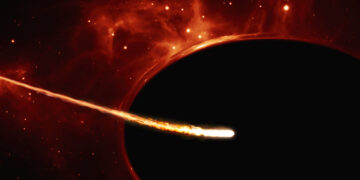The universe is full of mysteries, and one of the most perplexing has been the “final parsec problem”—a cosmic puzzle that seems to prevent supermassive black holes from merging. For decades, simulations showed these giants stuck in a near-eternal dance, unable to close the final parsec between them. But now, a groundbreaking study may have cracked the code, revealing self-interacting dark matter as the hidden force that finally brings these colossal objects together.
The Final Parsec Problem: A Cosmic Stalemate
At the heart of almost every galaxy, including our own Milky Way, lies a supermassive black hole. These behemoths, millions to billions of times the mass of the Sun, are thought to grow through repeated mergers with smaller black holes. Yet, when these black holes get close—within one parsec, or roughly 3.26 light-years—they should, according to simulations, spiral into each other and merge. Instead, the black holes become locked in an eternal orbit. This strange outcome arises because the black holes lose their ability to shed enough energy through interactions with surrounding matter. Once the material between them is exhausted, they can no longer draw closer.
This issue is what astrophysicists call the “final parsec problem.” If black holes can’t merge, it raises serious doubts about how supermassive black holes form in the first place. Given that we observe supermassive black holes in galaxies across the universe, including the famous one imaged by the Event Horizon Telescope in 2019, the existence of this stalemate presents a paradox.
The Role of Gravitational Waves in Uncovering the Solution
One of the clues that has helped researchers get closer to solving this problem came in 2023, when scientists using pulsar timing arrays detected a persistent background hum of gravitational waves.
These waves—ripples in space-time predicted by Einstein’s theory of general relativity—are released when two massive objects, like black holes, collide. However, the detected waves were much longer in wavelength than those previously observed, hinting at the involvement of incredibly massive objects, like supermassive black holes, that had somehow overcome the final parsec problem.
Researchers began to suspect that dark matter—specifically self-interacting dark matter—might be the missing ingredient needed to explain how these black holes were merging. Unlike ordinary dark matter, which interacts solely through gravity, self-interacting dark matter can interact with itself, absorbing and redistributing energy in ways that help black holes shed enough energy to complete their cosmic merger.
Self-Interacting Dark Matter: The Key to Merging Black Holes
So, how does SIDM work its magic? When two black holes spiral toward each other, they naturally draw in not just ordinary matter, but dark matter as well. In most models, this dark matter simply gets flung out as the black holes draw closer, reducing its effectiveness in helping the black holes merge. But in SIDM models, the dark matter behaves differently. Because SIDM particles can interact with one another, they form dense spikes around the black holes. These spikes help to absorb the orbital energy of the black holes, allowing them to move closer and eventually merger.
What makes this model particularly exciting is that it resolves a long-standing contradiction in astrophysics. Previous models showed that as the black holes moved closer, the surrounding dark matter would dissipate, reducing its effectiveness. However, with SIDM, the dark matter spikes replenish themselves, continuously aiding the black holes in their spiral toward collision.
The researchers behind this breakthrough, including Dr. Gonzalo Alonso-Álvarez, found that these self-interactions occur at just the right rate to solve the final parsec problem. Their simulations showed that the black holes could merge within a timescale of less than a billion years—well within the age of the universe.
Dark Matter and Cosmology
The implications of this research stretch far beyond solving the final parsec problem. It could fundamentally alter our understanding of dark matter, which remains one of the most mysterious substances in the universe. Dark matter makes up about 85% of the universe’s matter, yet it doesn’t interact with light, making it invisible and detectable only through its gravitational effects.
This new study suggests that SIDM could be the key to understanding not just black hole mergers, but also the distribution of dark matter on galactic scales.
Moreover, the model’s predictions match observations of gravitational waves, particularly the softening of gravitational wave frequencies detected by pulsar timing arrays. This softening occurs because the SIDM absorbs more energy at low frequencies, allowing the black holes to spiral inward more effectively. As new data from pulsar timing arrays continue to be collected, scientists hope to further confirm these findings, providing even stronger evidence for the existence of SIDM.
Looking Ahead: A New Era of Black Hole and Dark Matter Research
The discovery that SIDM could solve the final parsec problem marks an exciting moment in astrophysics. It not only provides a potential solution to a cosmic mystery that has puzzled scientists for decades, but it also offers a new way to probe the elusive nature of dark matter.
Future research will focus on gathering more observational data from gravitational wave detectors and pulsar timing arrays. As these observations accumulate, researchers will be able to refine their models and further test the role of SIDM in black hole mergers.
In the end, this research is more than just a solution to a specific astrophysical puzzle. It represents a major step forward in our quest to understand the fundamental forces and particles that govern the cosmos. And as scientists continue to explore the mysteries of black holes and dark matter, we may find that the final parsec problem was just the beginning of an even greater cosmic journey
Reference:
Alonso-Álvarez, G., Cline, J. M., & Wierda, A. (2024). Self-Interacting Dark Matter Solves the Final Parsec Problem of Supermassive Black Hole Mergers. Physical Review Letters, 133(2), 021401. https://doi.org/10.1103/PhysRevLett.133.021401



















